The auto industry, since its debut in the early 20th century, has completely reshaped humanity’s built environment. It has caused roads to be repaved while re-configuring the energy industry and even the manufacturing base around it.
Cars are the United States’ largest export industry. It employs over 4 million people domestically and for years has been seen as a rigid industry, with high barriers to entry, high upfront capital costs, and low margins. It’s no wonder that the industry saw effectively no new significant entrants for decades.
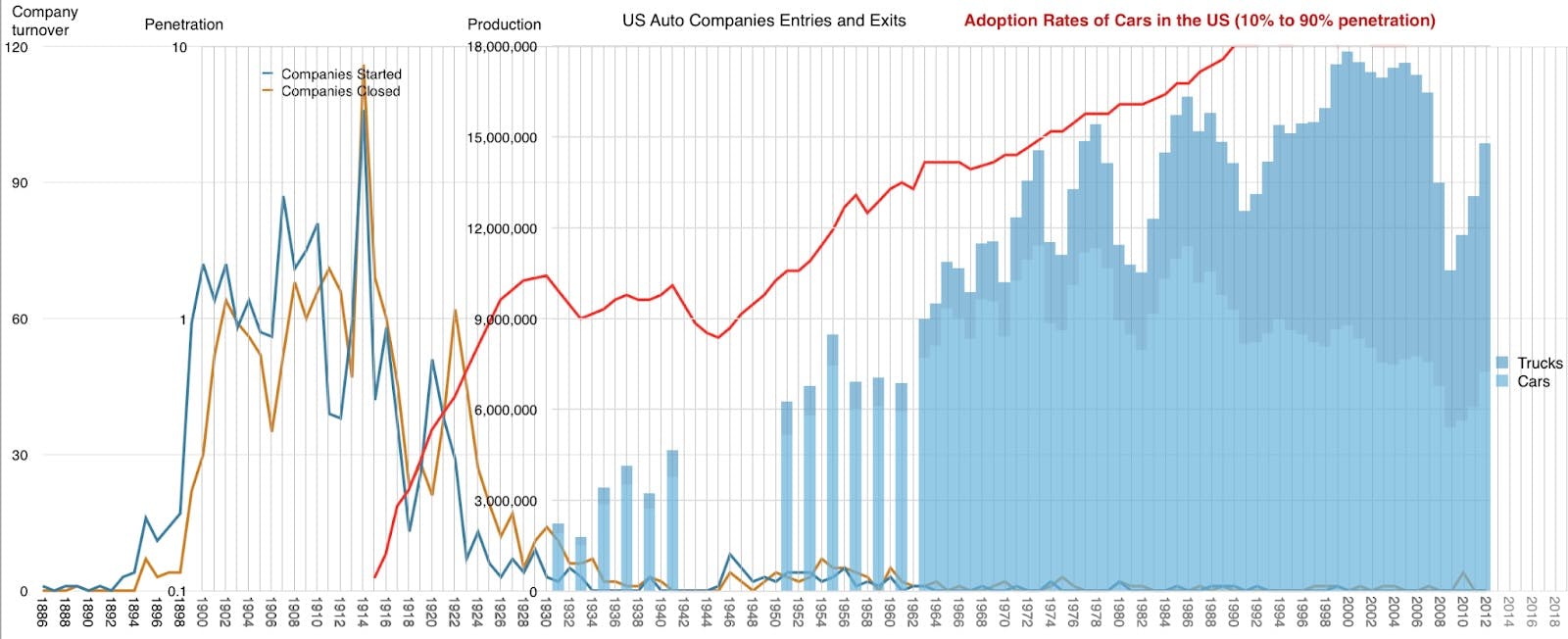
Source: Asymco
However, all of this changed with the launch of Tesla. Bolstered by greatly improved battery technology, and plans for a simpler and more automated manufacturing process than that accessible to traditional gas-powered car manufacturers, Tesla took the chance to become a new mass manufacturer of electric vehicles. Its IPO in 2010 was the first time an American car company went public since Ford did it in 1956.
Since then, the auto industry has been thrown into the midst of a vast sea-change. The swift adoption of electric vehicles — accounting for less than 1% of all vehicle sales in the US, now accounts for 7%.
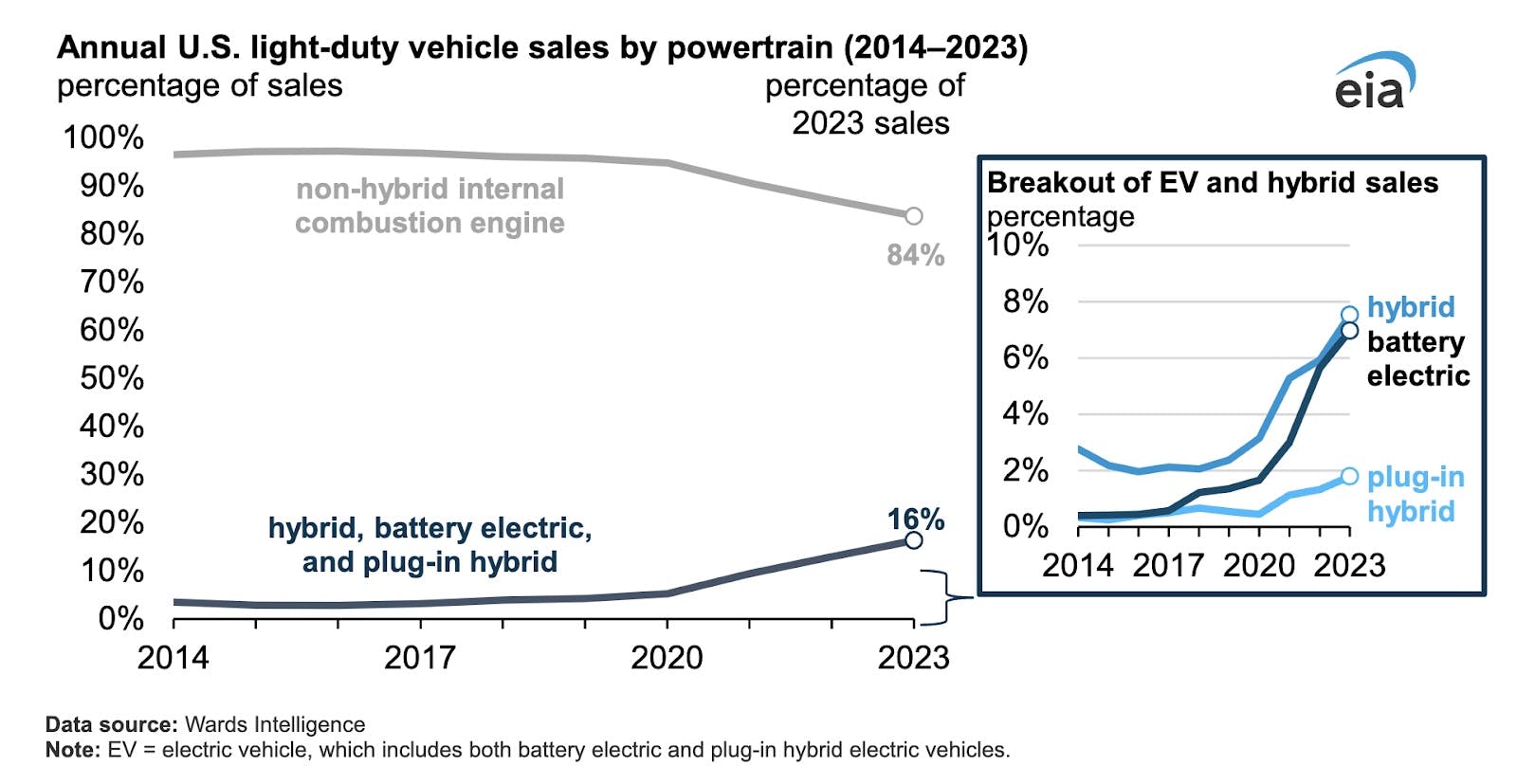
Source: EIA
As consumer trust and interest in electric vehicles grows, states and a host of traditional car manufacturers are pledging to make a complete shift to electric vehicles within a handful of years.
While there are some obstacles to getting everyone into an electric vehicle, primarily upgrading the grid to handle the increased loads, everything points to electric as our new future.
All this means that future icons of the automotive world might no longer be the German houses of Benz, Daimler, and Maybach, but instead a small coterie of startups from California — the birthplaces of Tesla, Rivian, and Lucid. Though the California tech scene might not be known for its vast manufacturing base, it is known for its prowess in hardware and software — the two domains that will matter most in an EV-dominated world.
The Electric Vehicle Revolution
By 2024, there were 1.4 billion cars active on roads. Globally, we produce over 80 million of them each year, with China leading the way at 30 million annually.
The impressive scale of this industry is no accident. Cars are the most complex mass-produced pieces of machinery that exist. This means that mass car manufacturing lives by the laws of economies of scale.
Making cars is not cheap, and requires massive upfront investment. Profiting from their manufacture therefore requires a remarkably streamlined production process that pumps out millions of them.
Around the world from South Korea to China to the United States, governments have played a large role in supporting automakers with subsidies designed to keep them afloat. Not only has car manufacturing been an important export business for all of these countries, it has also provided employment opportunities in the millions, increasing the incentive of governments to protect domestic car manufacturers through preferential treatment. This high barrier to entry is precisely the reason why there have been essentially no new entrants into the American car market for decades, and why those that did enter typically failed.
In fact, the largest car manufacturers in the US today have been around since the very beginnings of the car industry. Ford, General Motors, and Chrysler were already being called the Big Three manufacturers in the 1920s, when cars first started becoming common in the United States, and they continue to collectively retain over 40% market share to this day.
What has allowed legacy companies to succeed and endure for decades is a refined and streamlined production process. First inaugurated by Ford’s assembly line and perfect by Toyota’s Lean Manufacturing System, the production process itself, rather than any feature inherent in the cars, is the true technological innovation behind the automotive industry.
Understanding this allowed Tesla to defy the odds and become the first breakout automotive success story of the 21st century. Tesla benefited from improvements in battery design and density that had re-invigorated interest in electric vehicles, which could finally offer comparable speed and range to traditional gas-powered cars. After Elon Musk acquired Tesla from its original founder, Martin Eberhard, streamlined production became an integral component of the company’s vision.

Source: Teslarati
Part of the magic of electric vehicles is they can seriously economize the number of parts required to assemble a car. Whereas gas-powered vehicles can have thousands of moving parts that need assembly, Teslas only have 17. This is because electric vehicles don’t have engines, which require separate systems to manage fuel, air intake, cooling, lubrication, and exhaust. Electric vehicles just need a drivetrain, a motor, and a battery. Alongside building out gigafactories with impressive amounts of robotic automation built in to decrease the costs of assembly, Tesla has also implemented labor-saving designs like single-casting the chassis of the car, or what he calls gigacasting. This has allowed Tesla to cast the entire structure of the vehicle rather than assembling it from discrete parts.
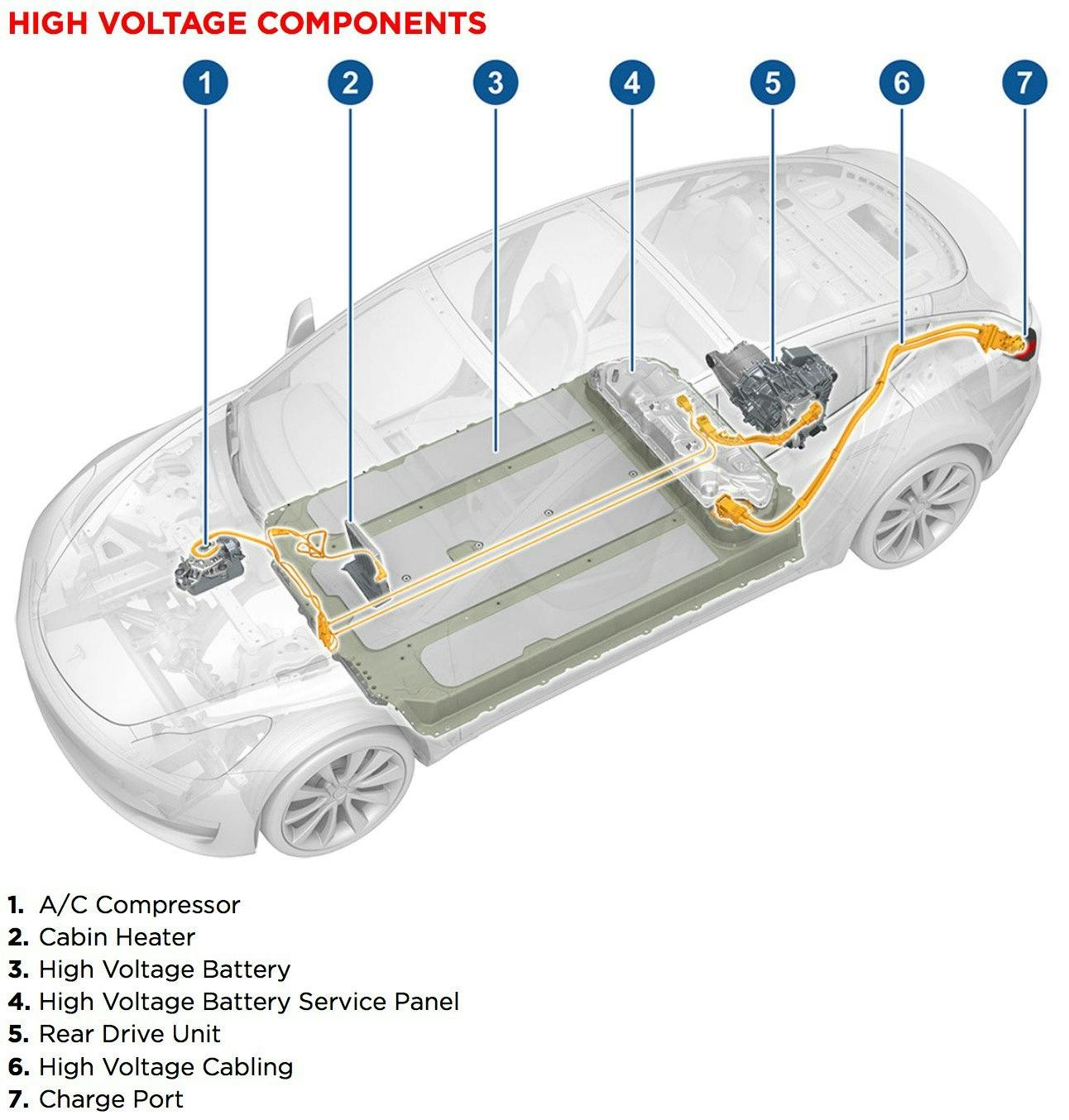
Source: Electrek
Despite their simpler construction relative to combustion vehicles, Teslas surprised to the upside with performance. The first Tesla Roadster could accelerate from zero to 60 miles per hour in 5.7 seconds — not terribly far from some of the supercars on the market at the time. Today, the Tesla Plaid can go from zero to 60 in just 1.9 seconds, the quickest of any vehicle in production.
In addition to their speed, Teslas are extremely energy efficient. Whereas gas-powered vehicles only achieve a 35% energy conversion efficiency from fuel — meaning that only 35% of the energy in the fuel is used to turn the car’s wheels — Tesla’s motors achieve 97% energy conversion from its battery.
Alongside that, the unique properties of Tesla’s vehicles, including empty space under the hood and trunk, and a low center of gravity compared to heavy engines stored in the front of gas-powered vehicles, have earned it the distinction of being one of the safest cars in the world. Head-on collisions that take place in a Tesla transfer much less impact on the driver than traditional vehicles.
With its speed, safety, and relatively low cost, Tesla was the first electric automaker to make the jump into mass production. Not only did it license out its electric motor designs to other companies like Daimler and Toyota, but in a 2014 blog post titled “All Our Patent Are Belong To You,” Elon Musk announced that Tesla would make all their patented technologies open-source. This opened the floodgates for the emergence of a new wave of electric vehicle manufacturers, including domestic EV companies like Lucid and Rivian.
By the start of the 21st century, it seemed utterly unlikely that a single company would come in and completely change the auto industry. And yet, by demonstrating that producing electric vehicles could be faster, more efficient, and more economical for consumers, Tesla did just that. In just a few years, Tesla did for electric vehicles what Ford’s Model-T did for gas-powered ones over one hundred years ago. It revolutionized expectations for car manufacturing and injected the first drips of demand into the electric vehicle market which hadn’t seen any invigorated interest since the 19th century.
A History of Cars
The story of cars really begins with steam, which was what powered the first engine. The steam engine, which combusted fuel to heat water to generate steam which produced pressure that pushed a piston, became the universal machine of the Industrial Revolution because it was so easily re-configurable. For instance, pistons could be used to pump water out of mines. Or, by connecting a piston to a rod and crank, you could convert its vertical force into a rotational force which could be used to power a cotton mill or a loom. By connecting the rod and crank mechanism to a set of wheels, you could even create a locomotive.
The impact of the steam engine on transportation, for both freight and passengers, was already being anticipated with great eagerness in the 18th century. In fact, even before the first railways were being laid to provide mass transport infrastructure, people were already envisioning self-propelled machines for individual transportation. One of these was French inventor Nicolas Joseph Cugnot.
In 1769, only five years after James Watt introduced his steam engine, Cugnot was experimenting with an early automotive device. He placed a steam-powered engine atop a wheeled, wooden platform, which created a kind of steam-powered tractor. While extremely unwieldy, this contraption could haul up to five tons at four kilometers per hour. Its principal drawback, however, was that it would only work for fifteen minutes before needing to be refueled with more wood to reheat the water and generate more steam.
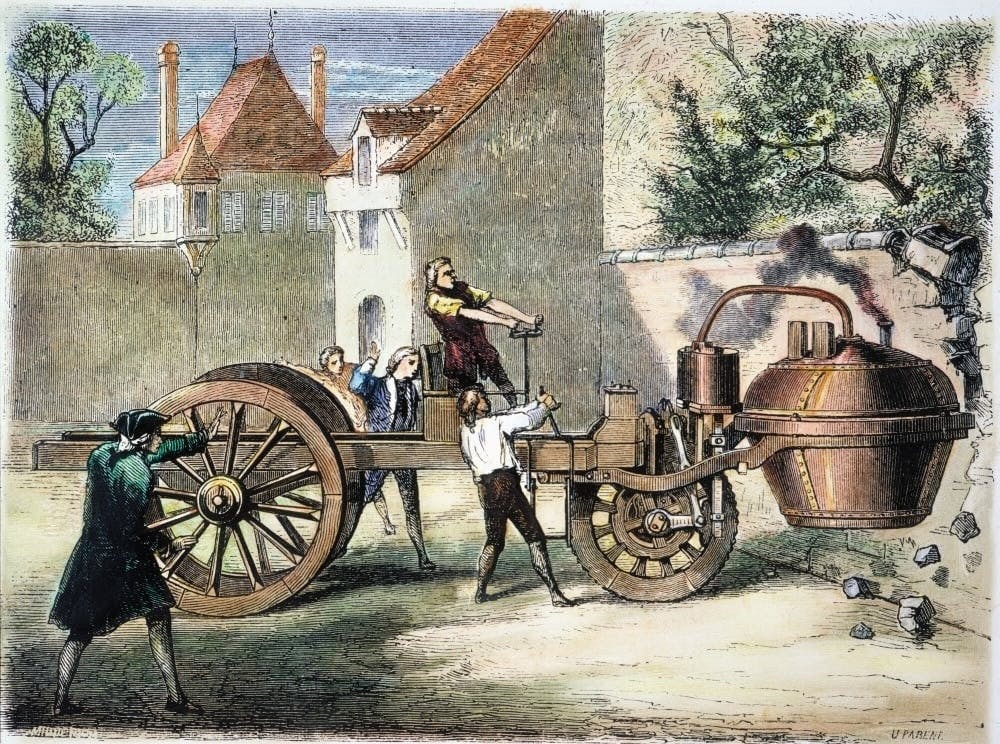
Source: Cugnot Print
Luckily, there was a new form of power emerging at this time — electric power. Alessandro Volta discovered how to store electric power with his voltaic pile, the first-ever battery, in 1800. Following this, Michael Faraday discovered how to harness it to produce the first electric motor in 1822. A mere ten years later, Scottish inventor Robert Anderson, produced the first prototype of an electric car — or “horseless carriage” as it was called at the time. The battery Anderson used was not rechargeable (that wouldn’t be possible until 1859 when Gaston Planté discovered the rechargeable lead-acid battery). However, Anderson’s car demonstrated that electricity could be a viable source of power for automobiles.
The first feasible electric car was produced by Gustave Trouvé in 1881 which he based on an improved design of Planté’s rechargeable battery. From then on, electric cars became quite popular. They were quiet and could be conveniently recharged with wall-mounted chargers in urban areas, much like in the present day.

Source: Thomas Edison in an electric car, Picryl
Within a few years, London, New York, and Paris all had battery-powered electric taxis roaming the streets. By 1900, a third of all cars on the road were electric. As if having steam, electric, and animal-powered vehicles on the road wasn’t competition enough, a fourth contender soon entered the ring: the petrol-powered vehicle.
It took until 1855 for people to realize that petrol could be used as a fuel. Before this, it was merely considered an annoying by-product of the subterranean search for brine. Limited quantities of it were sold at pharmacies, which marketed it as an ointment with medicinal qualities. In time, as the combustible nature of petroleum became clear, a handful of people began to realize just how much potential it had as a fuel. Not only was it light-weight, but there seemed to be untold quantities of it waiting to be pumped.
A further benefit of petroleum was that it could be used to produce an internal combustion engine — one where the pistons of the engine itself could be used to ignite the process of combustion, rather than having combustion be managed externally, as with coal- or steam-powered machines.
It was Nikolaus Otto, a talented German engineer, who in conjunction with Gottlieb Daimler and Wilhelm Maybach produced the first such internal combustion engine in 1876. The entire process of fuel injection, ignition, and conversion into rotational motion occurred inside a cylinder with four piston strokes. First, the piston descends, sucking air and fuel into the cylinder. In the second stroke, it comes up, compressing the fuel and air into a smaller volume. In the third stroke, a spark plug ignites the fuel and air mixture which pushes the piston back down again, powering a crankshaft. Finally, the piston comes back up to release the exhaust produced from combustion. These four steps are cheekily referred to by engineers as suck, squeeze, bang, and blow.

Source: Encyclopedia Britannica
Despite the exciting advances in automotive engineering, some, like the United Kingdom, had muted expectations for cars. For over thirty years, beginning in 1865, the British Parliament passed the Highways and Locomotives Act, setting the speed limit for automobiles at 2 miles per hour in towns. It also required that each vehicle be accompanied by a “man with a red flag,” walking 60 yards ahead of the vehicle.
In 1900, there were under 10,000 cars produced annually around the world. France and the United States led the way, each producing 4,000 cars annually at the time. They were followed by Germany, which was manufacturing less than a thousand. It seemed that every few years some new car design would break a new record. In 1899, the electric car named La Jamais Contente (the “never-satisfied”) became the first vehicle to break 100 kilometers per hour. Just a few years later, in 1906, a Stanley Steamer, a steam car, broke that record by going twice as fast. Remarkably, steam cars kept kicking for a few decades into the 20th century, even if certain models could take up to 45 minutes to power up. “In America steam cars outnumbered any other form of self-propelled vehicles in the early 1900s and steam production continued through the twenties,” writes Bryan Appleyard in his book The Car.
Becoming the dominant car manufacturer seemed like anyone's game until one man changed the industry forever. His innovation had little to do with re-engineering car design and more to do with re-engineering the production of cars. This man was Henry Ford, and he brought the assembly line into the world. With it, he would also determine the trajectory of the automotive industry for the century to come.
In 1906, only 25,000 cars were produced in America, which boasted a population of 100 million at the time. By 1923, America was producing over 3 million cars per year, and nearly two-thirds of them were Ford’s Model T. With each new year of production, Ford kept improving the efficiency of his assembly model. If in 1909, it took Ford 12 hours to assemble a Model-T, by 1914 it only took 93 minutes. Over the same time frame, the cost of the Model-T fell from $950 to $290 by the end of its production. When Model Ts stopped being produced, in 1927, Ford had made 15 million of them.
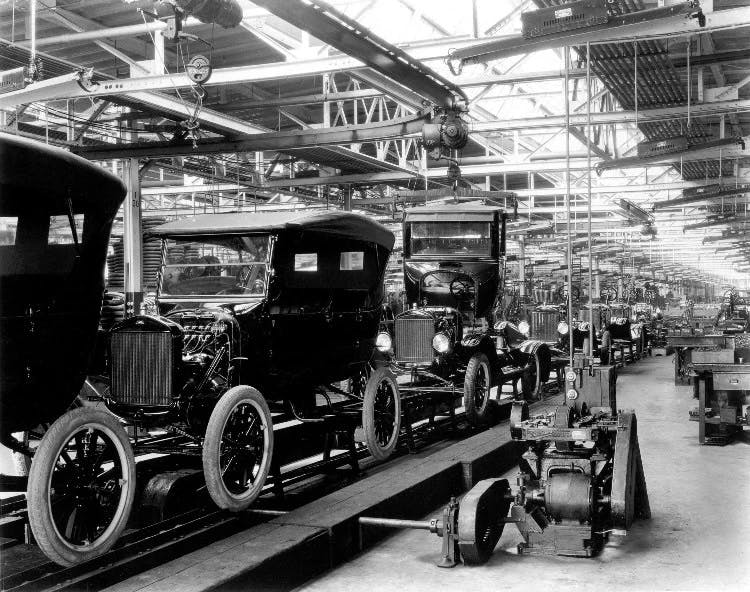
Source: History Hit
Model-Ts ran on gasoline. Their explosive debut in the American market laid the groundwork for a massive expansion of filling stations and the petroleum industry as a result. The rest was history.
Most rival manufacturers to Ford couldn’t compete with the efficiency of mass production. They had the choice of refining their own systems of mass production to compete on cost, or carving out a niche like luxury vehicles and targeting a smaller, more elite clientele to survive. The 253 independent American car makers in 1908 consolidated into just 44 by 1929, where nearly 80 percent of annual production was done by the Big Three American firms: Ford, General Motors, and Chrysler.
By then it was clear that the United States was becoming a car country. In 1956, President Dwight Eisenhower passed the Highway Act, ordering the construction of 41,000 miles of Interstate Highways within ten years. The move effectively terraformed the country, creating a massive interstate logistical network, dictating the layout of suburbs and cities, and opening untold new travel opportunities for American families. Cars and the highway system unlocked national parks and domestic travel to the public for the first time.
By the late 1970s, fuel price shocks caused the federal government to mandate that automakers attain certain fuel efficiency standards to decrease fuel costs for consumers. By then, many automakers were beginning to add features like turbochargers which would use the car’s exhaust to spin a turbine that would pull more air into the engine, increasing power for the same amount of fuel. However, greater fuel efficiency wasn’t just attained through engineering, but through design as well. Improving the aerodynamics of the vehicle, particularly decreasing drag, through techniques borrowed from auto racing and the aero industry, bore serious improvements in fuel efficiency. While it could cost hundreds of millions of dollars in research and development to achieve a one-tenth-mile-per-gallon increase in fuel efficiency, aerodynamic improvements, which cost nearly nothing, could deliver far greater gains.
If in 1985, average fuel efficiency was 27 miles to the gallon, today that number hovers around 36. By 2026, regulators hope American automakers can bring that number up to 40.
The Future of Mobility
However, improving fuel efficiency might not be enough to save the internal combustion engine. Today, the tide in the automotive world is shifting once again, away from cars with gas-guzzling engines to cars with no engines at all (i.e. electric vehicles). States like California, for instance, envision that all passenger cars, trucks, and SUVs sold in the state will be emission-free by 2035.
Though this date might seem an ambitious and far-off goal, it’s not all hot air. Many manufacturers are now either producing an electric model or are transitioning to becoming fully electric in the future. Audi announced it will only sell electric vehicles after 2026, as did Fiat (by 2027) and Mini (by 2030). Mercedes envisions that half of the cars they sell will be electric by 2026.
The benefits of switching to electric vehicle production don’t end with ending emissions. From the manufacturer’s perspective, they are wildly easier to assemble. Compared to traditional combustion-engine models which can contain thousands of individual parts, as part of the coolant, oil, and exhaust systems, Teslas are now only produced with 17. This makes factory-line automation and streamlining far easier while for consumers, it means fewer parts that require maintenance or replacement.
Furthermore, for developing countries without access to copious domestic sources of oil, like China, building out a fleet of electric vehicles is the most sensible way to ensure personal mobility for all who want it. In 2023, China was the world’s largest EV market, selling over 9 million cars that year.
For many in America, electric vehicles are already a more economical option than gas cars, though many still feature the drawback of limited range. However, to solve for this, a nationwide network of nearly 162,000 charging terminals has been built.
However, Edison Electric Institute’s 2022 report estimated that if 10% of cars on the road are electric by 2030, America will need something like 12 million charge ports and 140,000 fast charging stations. One of the biggest barriers to supplying all of this demand for electricity will ultimately fall on the grid, which seems to have great difficulty onboarding new sources of power generation and hasn’t seen massive upgrades in decades. Even so, it is certain that gasoline prices will only rise as time goes on, and electric vehicles may inevitably become the economic option for consumers.
The final major advantage of electric vehicles is that electric motors just go hand-in-hand with self-driving software. Imagine the headache of converting split-second software directives through mechanical parts, not to mention the room for error. The whole system is just cleaner when fully electric.
It seems that everything is conspiring to pave the way for an EV future. And, as the resources and will to invest in additional public transportation options dry up, the future of personal mobility will increasingly center around individual transport. With autonomous taxis already roaming the streets of San Francisco, it begs the question — will the skill of driving itself go the way of coding — something future generations might never have to learn?
The question of human control is perhaps the greatest sticking point in the total conversion to electric mobility. Bryan Appleyard writes, “These new vehicles might still be known as cars. But, apart from obvious similarities like wheels and bodywork, they will be something quite different. EVs do not need gears – this alone transforms the experience of driving whether you are used to an automatic or a manual gear change.” In other words, the honed cues of when to shift gears or rev the engine won’t be relevant anymore in an electric vehicle.
Over the years, there has been one niche industry that has prized the refinement of exactly such driving skills — racing. Organizations like Formula One have elevated the automotive arts, not only producing some of the finest drivers but also some of the finest engineers tasked with squeezing every bit of power out of the engine and every bit of gain out of aerodynamic design. They play upon the ambiguity and unsolved nature of engineering and human skill, leading the field to push the limits of both.
As electric supercars start coming on the market, hitting record acceleration speeds and beginning to inch their way to approach top speed records too, it may be that mechanical auto sports will go the way of horseback riding — once a powerful skill, now a celebrated stint at the Olympics.
Disclosure: Nothing presented within this article is intended to constitute legal, business, investment or tax advice, and under no circumstances should any information provided herein be used or considered as an offer to sell or a solicitation of an offer to buy an interest in any investment fund managed by Contrary LLC (“Contrary”) nor does such information constitute an offer to provide investment advisory services. Information provided reflects Contrary’s views as of a time, whereby such views are subject to change at any point and Contrary shall not be obligated to provide notice of any change. Companies mentioned in this article may be a representative sample of portfolio companies in which Contrary has invested in which the author believes such companies fit the objective criteria stated in commentary, which do not reflect all investments made by Contrary. No assumptions should be made that investments listed above were or will be profitable. Due to various risks and uncertainties, actual events, results or the actual experience may differ materially from those reflected or contemplated in these statements. Nothing contained in this article may be relied upon as a guarantee or assurance as to the future success of any particular company. Past performance is not indicative of future results. A list of investments made by funds managed by Contrary (excluding investments for which the issuer has not provided permission for Contrary to disclose publicly as well as unannounced investments in publicly traded digital assets) is available at www.contrary.com/investments.
Certain information contained in here has been obtained from third-party sources, including from portfolio companies of funds managed by Contrary. While taken from sources believed to be reliable, Contrary has not independently verified such information and makes no representations about the enduring accuracy of the information or its appropriateness for a given situation. Charts and graphs provided within are for informational purposes solely and should not be relied upon when making any investment decision. Please see www.contrary.com/legal for additional important information.



